Intraocular Pressure Damping by Corneal Elasticity and Viscosity Modulation Using Silicone Hydrogel Soft Contact Lenses
Abstract
1. Introduction
2. Materials and Methods
2.1. Study Design
2.2. Subjects
2.3. Contact Lenses Use
2.4. Biometric and Biomechanical Assessment
2.5. Statistical Analysis
3. Results
3.1. Biomechanical Changes After 10 Days of SiH-SCL Use
3.2. Biomechanical Changes After 20 Days of CL Use
4. Discussion
5. Conclusions
Funding
Data Availability Statement
Acknowledgments
Conflicts of Interest
References
- Ávila, F.J.; Marcellán, M.C.; Remón, L. On the Relationship between Corneal Biomechanics, Macrostructure, and Optical Properties. J. Imaging 2021, 7, 280. [Google Scholar] [CrossRef] [PubMed]
- Zarei, R.; Zamani, M.H.; Eslami, Y.; Fakhraei, G.; Tabatabaei, M.; Esfandiari, A.R. Comparing Corneal Biomechanics and Intraocular Pressure between Healthy Individuals and Glaucoma Subtypes: A Cross-Sectional Study. Ann. Med. Surg. 2022, 82, 104677. [Google Scholar] [CrossRef] [PubMed]
- Theo, G.; Seiler, P.; Shao, P.; Engler, M.; Beck, E.; Kochevar, I.E.; Yun, S.H. Corneal Hydration and the Relation to the Biomechanical Properties. Investig. Ophthalmol. Vis. Sci. 2017, 58, 4333. [Google Scholar]
- Studer, H.; Larrea, X.; Riedwyl, H.; Büchler, P. Biomechanical Model of Human Cornea Based on Stromal Microstructure. J. Biomech. 2010, 43, 836–842. [Google Scholar] [CrossRef]
- Allen, R.J.; De Wit, D.; Saleh, G. Applanation Tonometry in Silicone Hydrogel Contact Lens Wearers. Investig. Ophthalmol. Vis. Sci. 2004, 45, 1542. [Google Scholar] [CrossRef]
- Fırat, P.; Cankaya, C.; Doganay, S.; Cavdar, M.; Duman, S.; Ozsoy, E.; Koc, B. The Influence of Soft Contact Lenses on the Intraocular Pressure Measurement. Eye 2012, 26, 278–282. [Google Scholar] [CrossRef]
- Da Silva, F.; Lira, M. Intraocular Pressure Measurement: A Review. Surv. Ophthalmol. 2022, 67, 1319–1331. [Google Scholar] [CrossRef]
- Liu, Z.; Pflugfelder, S.C. The Effects of Long-Term Contact Lens Wear on Corneal Thickness, Curvature, and Surface Regularity. Ophthalmology 2000, 107, 105–111. [Google Scholar] [CrossRef]
- Peyman, A.; Ghoreishi, M.; Hashemi-Estabragh, S.S.; Mirmohammadkhani, M.; Mohammadinia, M.; Pourazizi, M. Corneal Biomechanical Properties after Soft Contact Lens Wear Measured on a Dynamic Scheimpflug Analyzer: A Before and After Study. J. Fr. Ophtalmol. 2021, 44, 391–396. [Google Scholar] [CrossRef]
- Saliman, N.H.; Morgan, P.B.; MacDonald, A.S.; Maldonado-Codina, C. Subclinical Inflammation of the Ocular Surface in Soft Contact Lens Wear. Cornea 2020, 39, 146–154. [Google Scholar] [CrossRef]
- Mohd-Ali, B.; Chen, L.Y. The Morphology of Corneal Endothelial Cells in Long-Term Soft Contact Lens Wearers in Kuala Lumpur. Contact Lens Anterior Eye 2021, 44, 72–75. [Google Scholar] [CrossRef] [PubMed]
- Mutwaly, R.F., Sr. Corneal Endothelial Polymegathism and Pleomorphism Induced by Daily-Wear Soft Contact Lenses. Cureus 2024, 16, e74187. [Google Scholar] [CrossRef] [PubMed]
- Abdolalizadeh, P.; Karimi, M.; Latifi, G.; Nouri, L.; Hashemian, M.N.; Hashemian, H.; Mehrpour, M.; Alipour, F. Role of Different Types of Contact Lenses in Epithelial Thickness. Eye Contact Lens 2022, 48, 210–216. [Google Scholar] [CrossRef] [PubMed]
- Zhang, J.; Kim, K.; Kim, H.J.; Meyer, D.; Park, W.; Lee, S.A.; Dai, Y.; Kim, B.; Moon, H.; Shah, J.V.; et al. Smart Soft Contact Lenses for Continuous 24-Hour Monitoring of Intraocular Pressure in Glaucoma Care. Nat. Commun. 2022, 13, 5518. [Google Scholar] [CrossRef]
- Marcellán, M.C.; Remón, L.; Ávila, F.J. Corneal Hysteresis and Intraocular Pressure Are Altered in Silicone-Hydrogel Soft Contact Lenses Wearers. Int. Ophthalmol. 2022, 42, 2801–2809. [Google Scholar] [CrossRef]
- Zimprich, L.; Diedrich, J.; Bleeker, A.; Schweitzer, J.A. Corneal Hysteresis as a Biomarker of Glaucoma: Current Insights. Clin. Ophthalmol. 2020, 14, 2255–2264. [Google Scholar] [CrossRef]
- Xu, Y.; Ye, Y.; Chen, Z.; Xu, J.; Yang, Y.; Zhang, Y.; Liu, P.; Fan, Y.; Chong, I.T.; Yu, K.; et al. The Impact of Intraocular Pressure Changes on Corneal Biomechanics in Primary Open-Angle Glaucoma. Am. J. Ophthalmol. 2025, 269, 216–225. [Google Scholar] [CrossRef]
- Deol, M.; Taylor, D.A.; Radcliffe, N.M. Corneal hysteresis and its relevance to glaucoma. Curr. Opin. Ophthalmol. 2015, 26, 96–102. [Google Scholar] [CrossRef]
- Sit, A.J.; Chen, T.C.; Takusagawa, H.L.; Rosdahl, J.A.; Hoguet, A.; Chopra, V.; Richter, G.M.; Ou, Y.; Kim, S.J.; WuDunn, D. Corneal Hysteresis for the Diagnosis of Glaucoma and Assessment of Progression Risk: A Report by the American Academy of Ophthalmology. Ophthalmology 2023, 130, 433–442. [Google Scholar] [CrossRef]
- Glass, D.H.; Roberts, C.J.; Litsky, A.S.; Weber, P.A. A Viscoelastic Biomechanical Model of the Cornea Describing the Effect of Viscosity and Elasticity on Hysteresis. Investig. Ophthalmol. Vis. Sci. 2008, 49, 3919–3926. [Google Scholar] [CrossRef]
- Ávila, F.J.; del Barco, Ó.; Marcellán, M.C.; Remón, L. A Comprehensive Study on Elasticity and Viscosity in Biomechanics and Optical Properties of the Living Human Cornea. Photonics 2024, 11, 524. [Google Scholar] [CrossRef]
- Çavdarlı, C.; Topçu-Yılmaz, P. Does Long-Term Soft Contact Lens Wear Affect Corneal and Anterior Chamber Parameters? Turk. J. Ophthalmol. 2018, 48, 166–170. [Google Scholar] [CrossRef] [PubMed]
- Rayess, Y.; Arej, N.; Abdel Massih, Y.; Antoun, J.; Waked, N. Influence of Soft Contact Lens Material on Corneal Warpage: Prevalence and Time to Resolution. Can. J. Ophthalmol. 2018, 53, 135–138. [Google Scholar] [CrossRef] [PubMed]
- Radaie-Moghadam, S.; Hashemi, H.; Jafarzadehpur, E.; Yekta, A.A.; Khabazkhoob, M. Corneal Biomechanical Changes Following Toric Soft Contact Lens Wear. J. Ophthalmic Vis. Res. 2016, 11, 131–135. [Google Scholar] [PubMed]
- Ramasubramanian, D.; Hernández-Verdejo, J.L.; López-Alonso, J.M. Influence of Contact Lens Parameters on Cornea: Biomechanical Analysis. Bioengineering 2024, 11, 966. [Google Scholar] [CrossRef]
- Liu, J.; He, X. Corneal Stiffness Affects IOP Elevation During Rapid Volume Change in the Eye. Investig. Ophthalmol. Vis. Sci. 2009, 50, 2224–2229. [Google Scholar] [CrossRef]
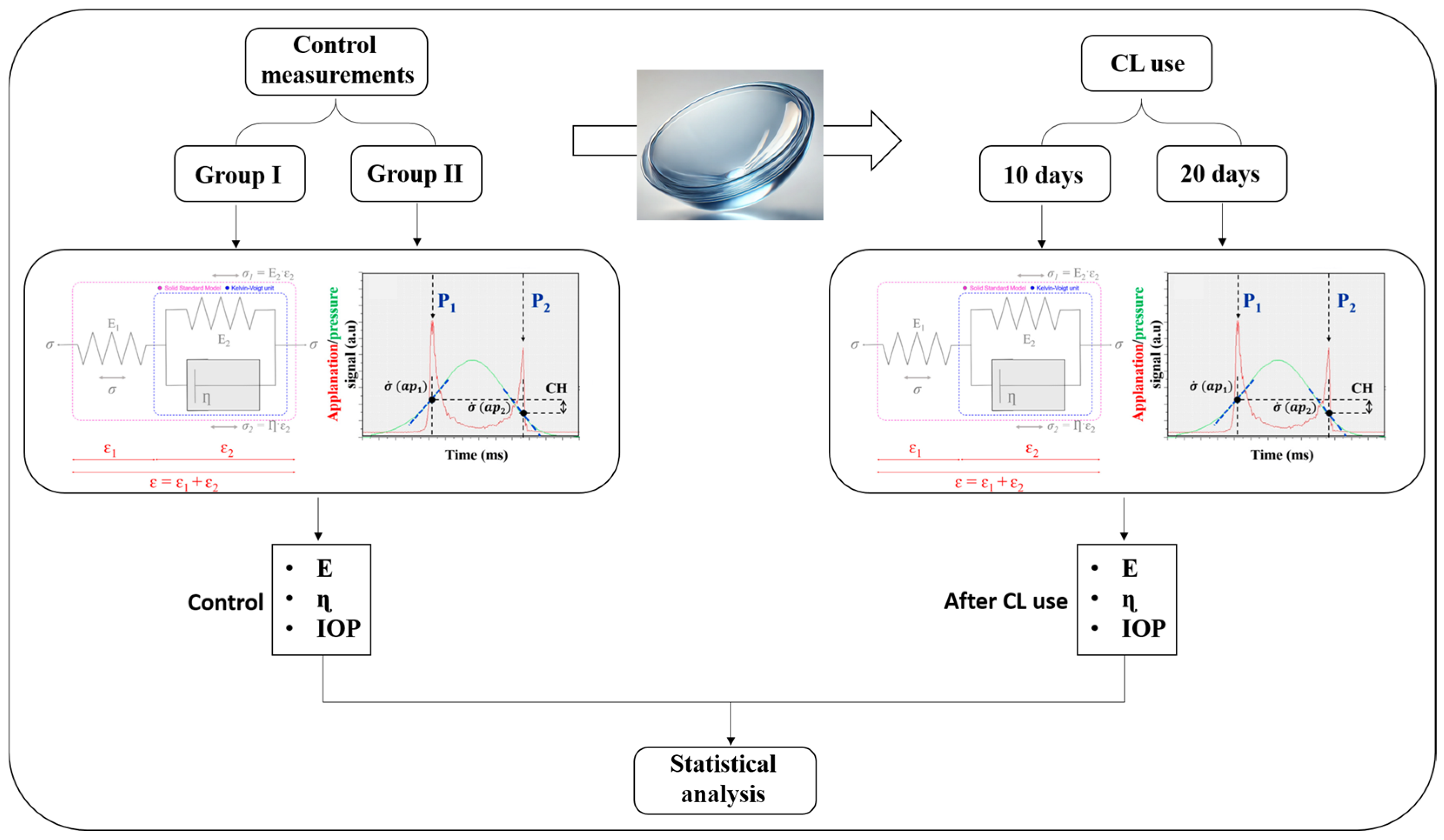
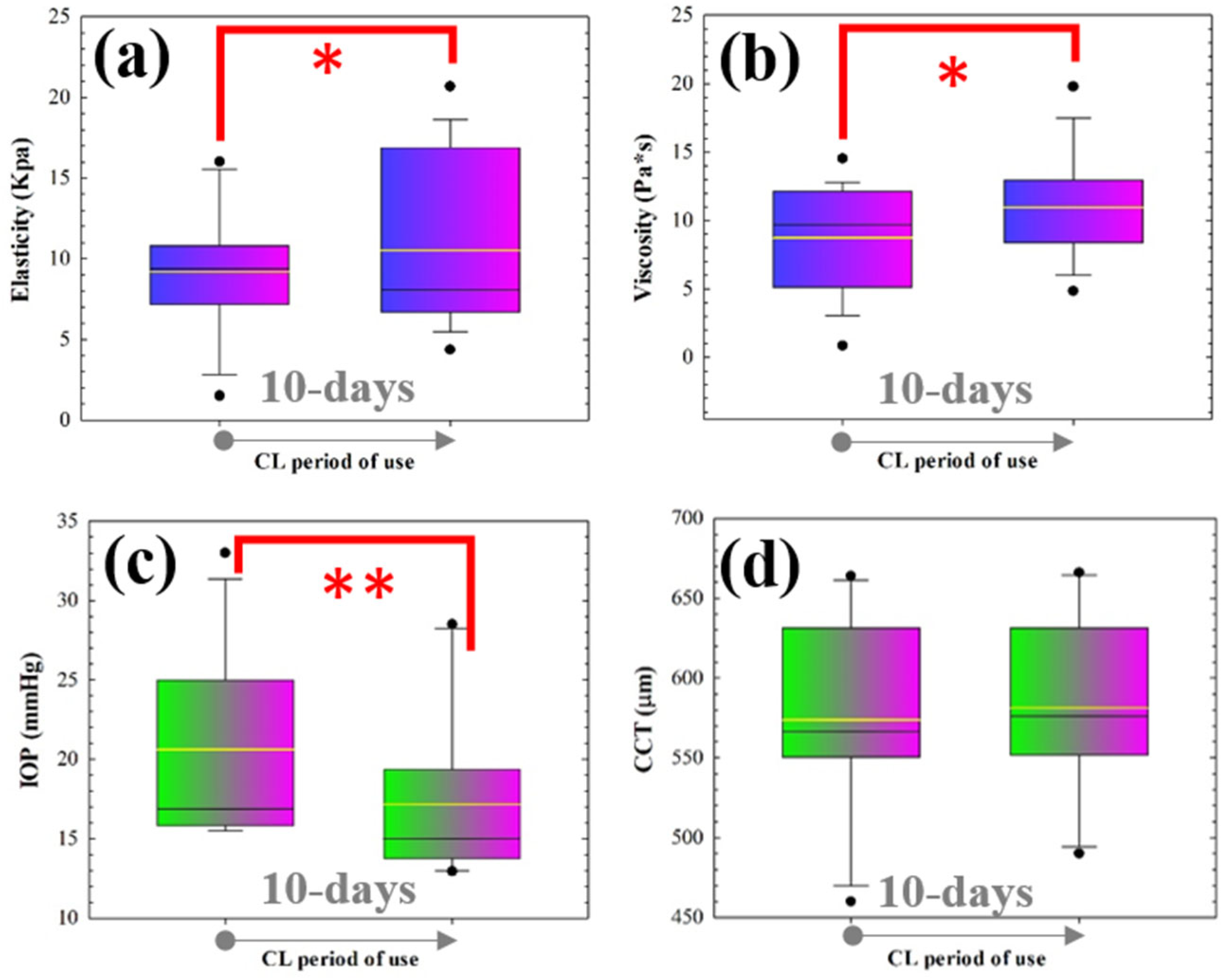
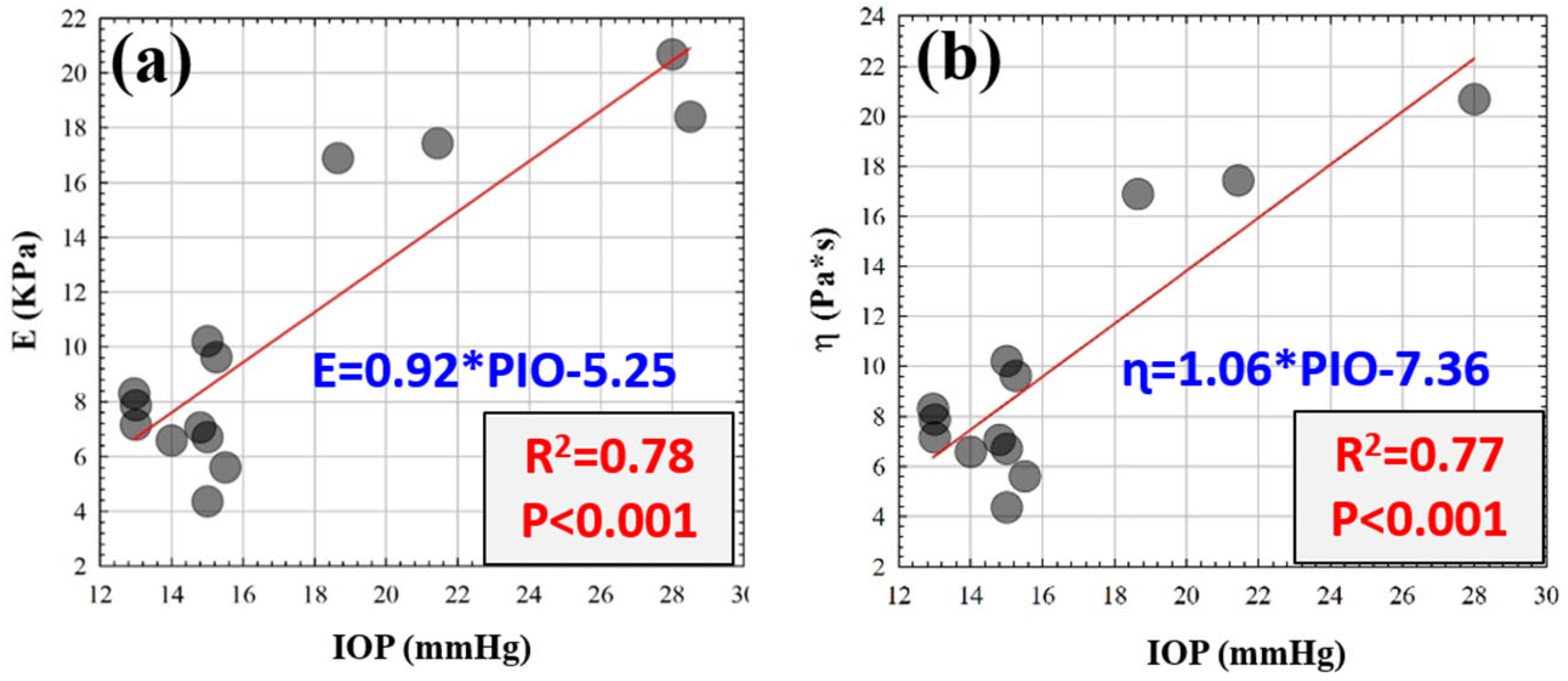
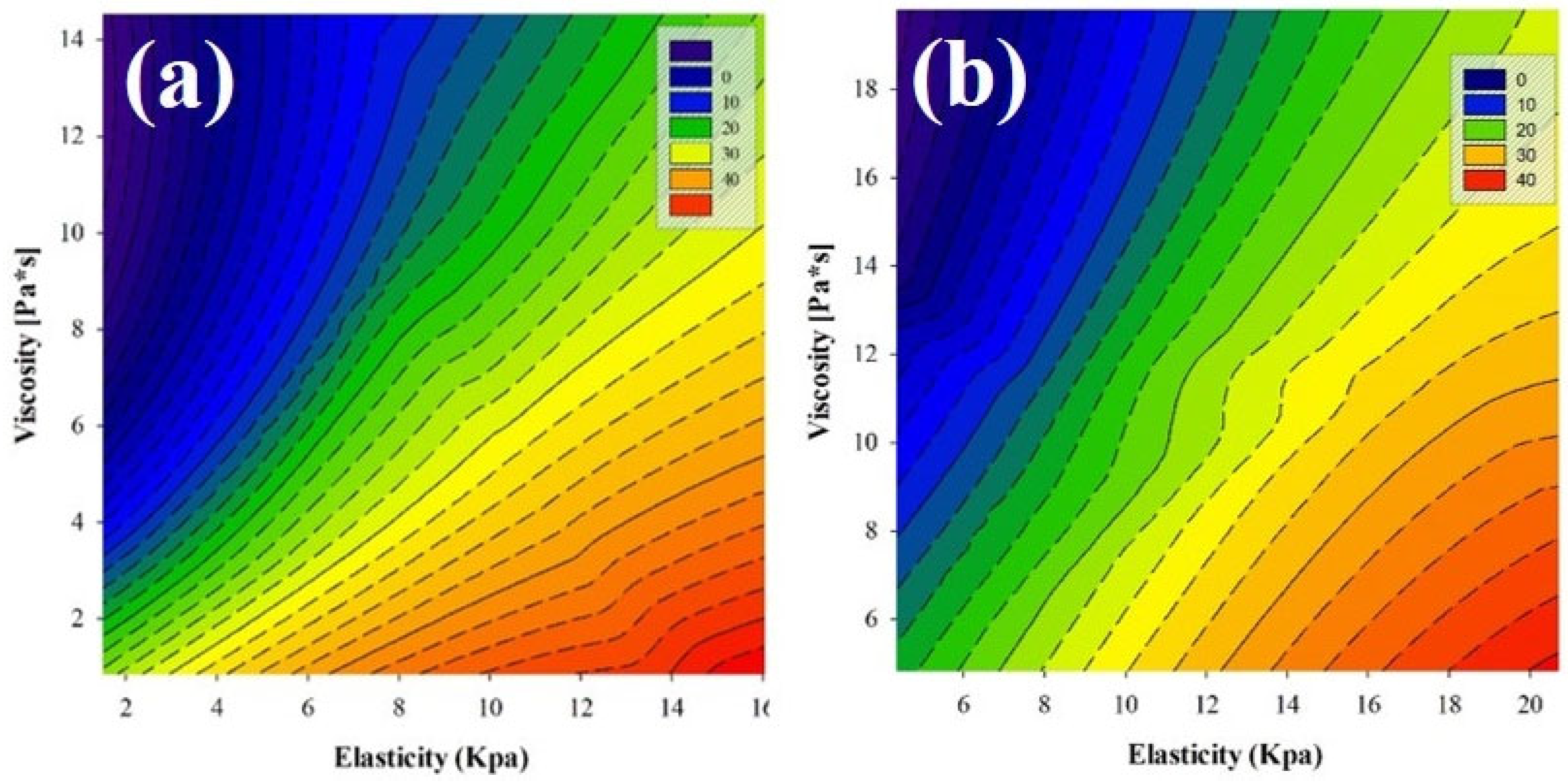
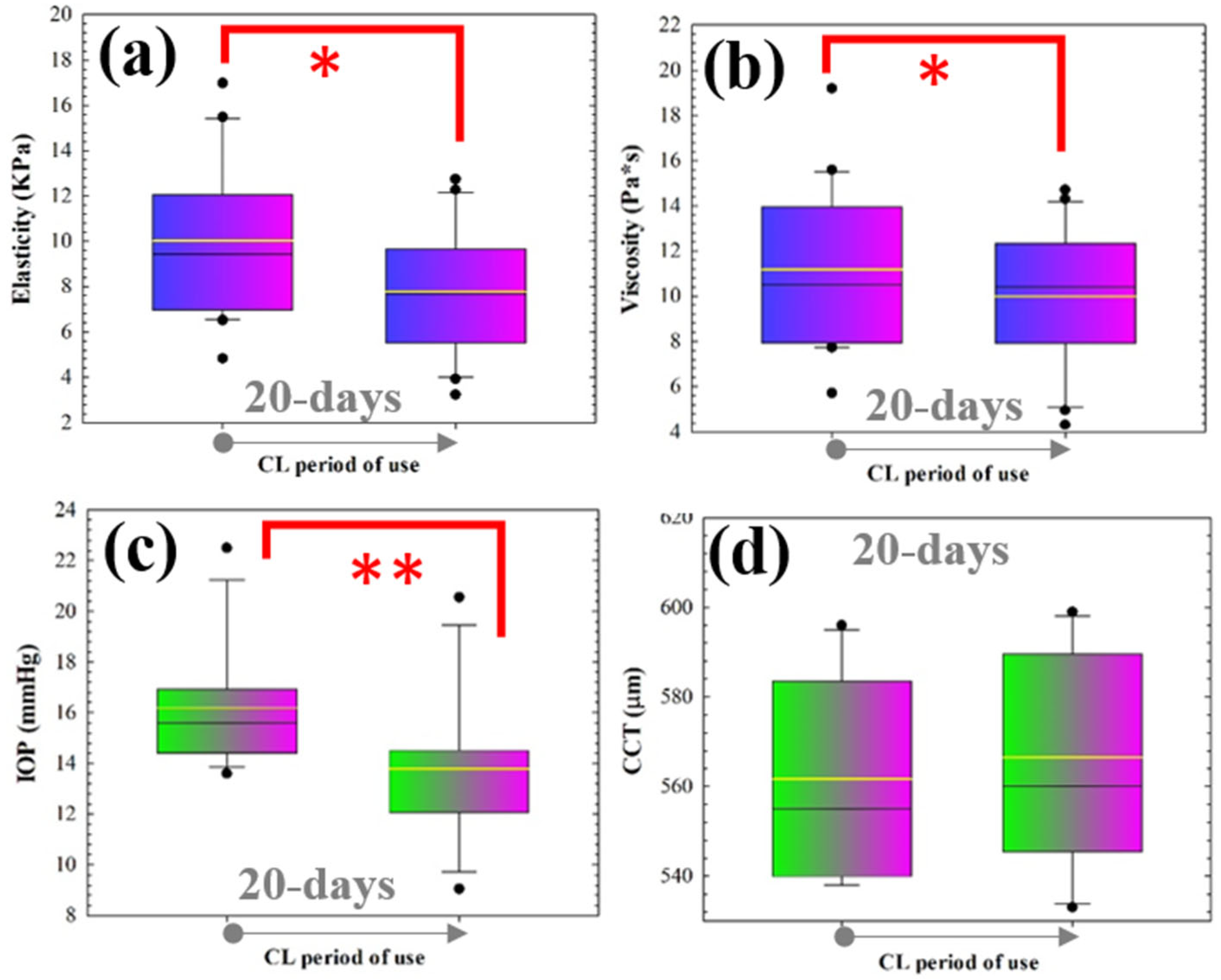

| Group I | Group II | |
|---|---|---|
| Age | 22.87 ± 4.14 (y.o.) | |
| Gender (M/F) | 13 F/1 M | 15 F/1 M |
| Ethnicity | European Caucasian | European Caucasian |
| Daily time and period of use | 8 h/10 days | 8 h/20 days |
Disclaimer/Publisher’s Note: The statements, opinions and data contained in all publications are solely those of the individual author(s) and contributor(s) and not of MDPI and/or the editor(s). MDPI and/or the editor(s) disclaim responsibility for any injury to people or property resulting from any ideas, methods, instructions or products referred to in the content. |
© 2025 by the author. Licensee MDPI, Basel, Switzerland. This article is an open access article distributed under the terms and conditions of the Creative Commons Attribution (CC BY) license (https://creativecommons.org/licenses/by/4.0/).
Share and Cite
Ávila, F.J. Intraocular Pressure Damping by Corneal Elasticity and Viscosity Modulation Using Silicone Hydrogel Soft Contact Lenses. Optics 2025, 6, 18. https://doi.org/10.3390/opt6020018
Ávila FJ. Intraocular Pressure Damping by Corneal Elasticity and Viscosity Modulation Using Silicone Hydrogel Soft Contact Lenses. Optics. 2025; 6(2):18. https://doi.org/10.3390/opt6020018
Chicago/Turabian StyleÁvila, Francisco J. 2025. "Intraocular Pressure Damping by Corneal Elasticity and Viscosity Modulation Using Silicone Hydrogel Soft Contact Lenses" Optics 6, no. 2: 18. https://doi.org/10.3390/opt6020018
APA StyleÁvila, F. J. (2025). Intraocular Pressure Damping by Corneal Elasticity and Viscosity Modulation Using Silicone Hydrogel Soft Contact Lenses. Optics, 6(2), 18. https://doi.org/10.3390/opt6020018






